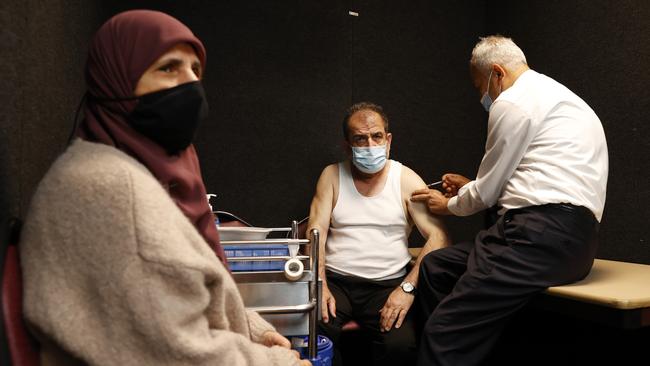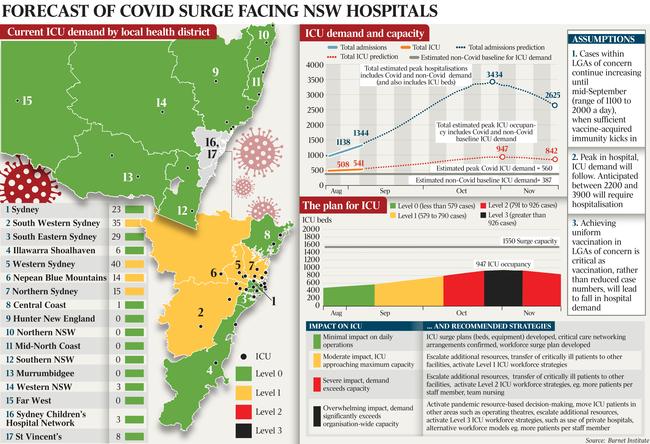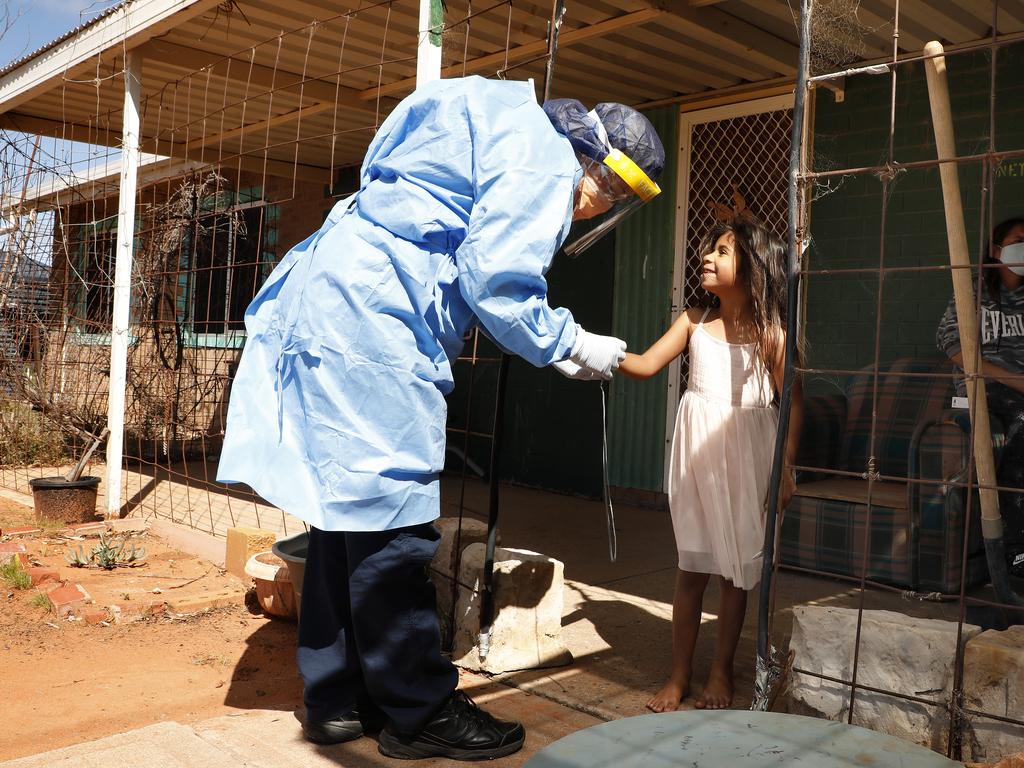Coronavirus vaccine rates surging in Sydney hotspots
Vaccination rates have soared in some of the Sydney suburbs worst affected by the Covid-19 outbreak.

Vaccination rates have soared in some of the Sydney suburbs worst affected by the Covid-19 outbreak, putting them well above the national average as the NSW government pushes ahead with plans to lift health restrictions.
Almost 86 per cent of residents in the Blacktown local government area have received their first dose of the Covid-19 vaccine, the sixth-highest coverage rate across any part of the country.
The new vaccine coverage figures came as modelling for the NSW government forecast the outbreak to peak with 2000 daily infections in mid-September.
The modelling, prepared by the Burnet Institute, suggests hospital intensive care units may have to move to a status classed as “overwhelming impact” as total admissions triple in October.
Gladys Berejiklian will press ahead with planned health restriction relaxations, starting Monday, and said ICU capacity could be expanded to 1550 patients.
“We certainly don’t want to have to use all of those beds and staff because we know what pressure it will put on the system, but we want everybody to be reassured that the capacity is there,” the NSW Premier said.
Anthony Holley, the president of the Australian and New Zealand Intensive Care Society, said ICU nurses who worked at a ratio of one nurse to one patient would likely face increased workloads.
“The way that could work is that you could have one qualified critical care nurse supervising two other nurses with a good skill set, but not necessarily having a certificate in critical care,” he said.
If Covid-19 patients in ICU exceeded 1000 then interstate support would likely be required “in one shape or another”, including the use of additional staff, Dr Holley told The Australian.
But Australia was in a stronger position than most other countries, he said, with a ratio of 9.1 ICU beds per 100,000 people, compared with 3.4 in Britain.
Ms Berejiklian is this week expected to announce further details of rule relaxations – contingent on 70 per cent of residents being fully vaccinated.
Data released by the commonwealth showed Queenscliffe, a small government area near Geelong, has the country’s highest single-dose rate – 91.8 per cent.
But the local councils of Blacktown, Campbelltown and Parramatta – all classified as areas of concern by the NSW government – had first-dose coverage rates of more than 80 per cent.
There were five deaths and 1281 cases recorded in NSW on Monday – 831 in Sydney’s western and southwestern suburbs – while Victoria reported 246 new infections.
The ACT recorded 11 cases.
In Victoria, Daniel Andrews has also outlined a vaccine-dependent road map out of lockdown. On Monday, the Victorian Premier said he hoped regional areas in his state would come out of the lockdown next week.

“That’s great news for regional Victoria but it would also be a pretty logical place for us to do some of this piloting work,” he said.
Across Victoria, 61 per cent of adults have received at least one dose. In NSW, 74.1 per cent of people have received their first dose of a vaccine, with 41 per cent of residents fully inoculated.
The NSW modelling released on Monday predicts a spike in case numbers to occur next week followed by a significant increase in hospitalisations during the latter half of October and the first two weeks of November. It will occur just as the state embarks upon its most ambitious plans to reopen the economy.
The six-page document predicts that ICU occupancy – including non-Covid related cases – will reach 947 cases in October before tapering off in late November.
Of these cases, approximately 560 are expected to be directly attributable to Covid-19. As of Monday there were 177 Covid-19 patients receiving intensive care across the state’s hospitals, including three children.
To cope with the strain on ICU operations, operating theatres will be used as makeshift intensive care facilities and each staff member will be tasked with a higher number of patients. Other “pandemic resource-based strategies” will also be deployed, the document said. “Achieving uniform vaccination in the LGAs of concern is critical as vaccination rather than reduced infection numbers will be the intervention that leads to a fall in hospitalisation,” the modelling stated.
The modelling indicates that the health system will likely experience an “overwhelming impact” on its usual operations during mid-October, the designation being the highest level of impact specified in the document; others include “minimal”, “moderate” and “severe”.
Last week the Australian Medical Association wrote to Scott Morrison and state and territory leaders warning that the nation’s hospitals were “ill prepared for plans to open up” their respective state economies.
Omar Khorshid, the association’s president, said although he believed expanded ICUs would be able to cope with increasing numbers of Covid-19 patients, he cautioned there may be ongoing elective surgery suspensions.
“In order to look after the people with Covid we’re going to compromise the care of everyone else,” Dr Khorshid said.
Health Services Union NSW secretary Gerard Hayes said the modelling showed a system “planning for the worst and hoping for the best”, which made “good sense”. But he cautioned that regional and rural centres would be far more vulnerable if an outbreak were to occur during the peak hospitalisation period across Sydney.
“Unfortunately, the same capacity does not exist in the regions, where the distances are longer and the ICU capacity is lower. We simply cannot afford a significant delta outbreak outside.”
More Coverage








To join the conversation, please log in. Don't have an account? Register
Join the conversation, you are commenting as Logout